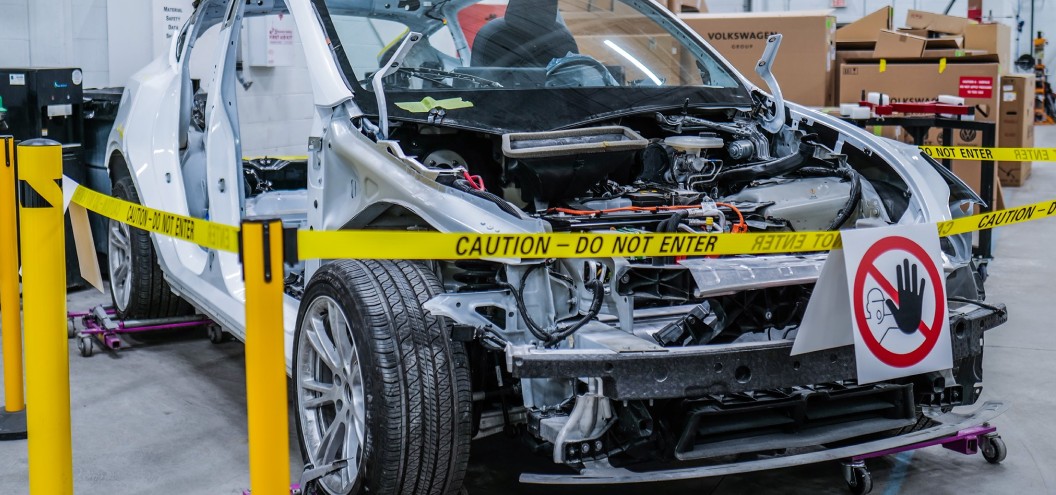When considering a new vehicle, safety is paramount. Automakers prioritize safety features in modern cars, both to prevent accidents and to protect occupants if a collision occurs. Electric vehicles (EVs), including hybrids and plug-in hybrids, adhere to the same rigorous crash safety standards as traditional gasoline-powered cars. Furthermore, EVs often boast advanced active safety technologies such as adaptive cruise control, lane departure warnings, and sophisticated camera systems.
In the unfortunate event of an accident, an electric car is engineered to protect you and your passengers just as effectively as a conventional vehicle. However, repairing an electric car, with its high-voltage systems and unique construction, requires specialized knowledge and procedures. Choosing the right repair facility is crucial to ensure your EV is restored to its pre-accident safety and operational standards.
The Unique Safety Considerations of Electric Car Repair
Under normal operating conditions, the high-voltage systems in your electric or hybrid car function seamlessly and safely. However, accidents can compromise these systems. High-voltage (HV) cables, typically identified by their bright orange color, can be severed in a crash, posing a significant risk of electric shock to anyone handling them without proper training and protective gear.
It’s important to understand that not all collision repair shops are equipped to handle the complexities of electric vehicle repair. Specialized training, infrastructure, and equipment are essential for working with the high-voltage systems found in EVs and plug-in hybrids. This specialized capability is not only necessary for proper repair but also to ensure the safety of the technicians working on your vehicle.
One of the unique procedures in electric car repair following a collision involves the careful handling and quarantining of the high-voltage battery. Improper handling of a damaged EV battery can lead to fire or other hazardous situations. The battery removal process itself requires specific procedures, and maintaining the battery’s charge level during the repair is crucial for its performance and longevity once reinstalled.
These specialized procedures necessitate dedicated equipment, ranging from EV-specific charging and maintenance tools to, in some cases, specialized battery quarantine areas within the repair facility.
The Advanced Materials in Electric Vehicle Construction
To counteract the considerable weight of their battery packs and achieve acceptable driving ranges, many electric and hybrid vehicles utilize advanced multi-material structures. These structures are significantly more complex than the traditional steel frames found in gasoline cars. For example, Tesla’s Model S features an all-aluminum body structure, while BMW’s i series incorporates a blend of steel, aluminum, and carbon fiber, a technology BMW refers to as “carbon core.”
Repairing vehicles constructed with these advanced materials demands specialized tools, equipment, and repair techniques. Automakers provide specific training programs for their certified body shops to ensure that repairs are carried out correctly, maintaining the vehicle’s structural integrity and safety. Choosing a certified shop ensures technicians are trained in these advanced repair methodologies.
Restoring the Electronic Systems of Your Electric Car
The intricate electronic systems within a hybrid or electric vehicle require careful management during post-collision repairs. Think of it as putting the car on automotive life support. This includes maintaining the high-voltage battery in optimal condition, as improper handling can render it unusable. Furthermore, all of the vehicle’s numerous control modules must be carefully managed to ensure they function correctly and communicate seamlessly after the repair.
A repair facility that is both manufacturer-certified and EV-specialized will possess the necessary equipment to handle these sensitive electronic components. Importantly, through manufacturer certification, they gain access to detailed documentation outlining the precise procedures for restoring your electric vehicle to its operational state after repairs.
Industry sources like Body Shop Business emphasize the complexity of EV battery handling: “Removing and installing an EV battery is no small feat. Regardless of type, they are large and heavy. There is typically special equipment to support the battery and assist with this process. A scissor-lift platform or mobile battery table fixture is typically used. Depending on the procedure, the battery or the vehicle is raised or lowered to join the two. Either way, precision is the key and special tools such as alignment dowels are often used. For fixed connectors, the use of a borescope may prove essential to visually verify the proper alignment of the connectors before mating the battery to the vehicle body.” This highlights the need for specialized equipment and trained technicians in EV battery repair and replacement.
Conclusion: The Critical Step of Safety System Recalibration
Finally, a crucial aspect of electric car repair is the recalibration of the many active safety systems present in modern vehicles, particularly EVs. Systems like lane departure warning, which rely on side-view cameras to read road markings, require precise re-aiming and refocusing using automaker-specific patterns and tools.
Advanced systems such as adaptive cruise control, which integrates radar and cameras, may even necessitate a specialized calibration room equipped with test patterns to ensure accurate functionality. Therefore, confirming that your chosen body shop is properly equipped for calibrating these advanced safety systems is essential.
The overarching message is that modern vehicles, and especially electric vehicles, are sophisticated machines. They often incorporate advanced materials and complex systems that demand specialized care and expertise to restore them to factory specifications after a collision.
For ultimate peace of mind, selecting a repair facility certified by your electric vehicle’s manufacturer is the most prudent decision. Nearly all EV manufacturers have body shop certification programs that include rigorous training and equipment requirements. This certification serves as your assurance that your electric car will be repaired to the highest standards, ensuring your safety and the vehicle’s performance for years to come.


